Additive Curriculum
Innovation in pedagogy
Innovation in Pedagogy - Additive Curriculum
Objectives of the Practice
In today’s technology-driven world, the human brain is constantly bombarded by information from numerous devices which it must navigate to survive. Through Neuroplasticity, it constantly reorganizes itself which also changes the way it functions. Gen Z children are impacted most by this phenomenon and display new behaviours (Fig 1).
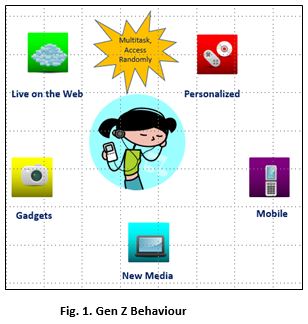
Research showed students learn best when they,
- are engaged with what they are studying,
- are making decisions,
- are thinking critically,
- work in teams.
The Context
The context is the employability of our students and their ability to thrive in an ever-changing external environment. There are various challenges that need to be addressed before our students can get employed.
Our first challenge was the problems the industry faces currently (Fig 2). All stakeholders must become aware of this reality.
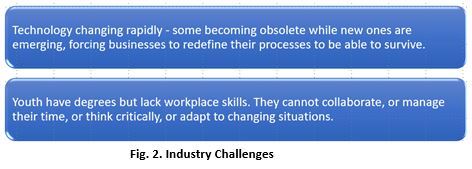
- The second challenge is the direct impact this has on students as well (Fig. 3). The situation makes them vulnerable to being unemployed.
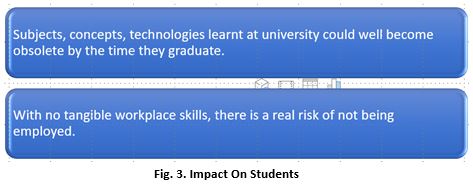
- The third challenge was that the strengths of this re-organized brain was not being leveraged to prepare them for the future (Fig. 4).
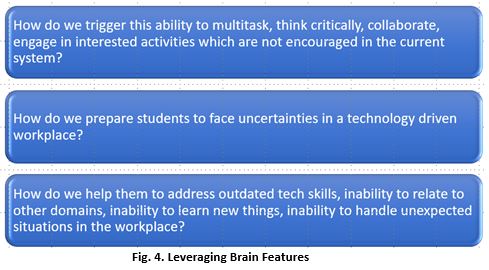
NU decided to address these challenges pedagogically as early as 2012. Based on the Learning Engineering framework of the Educational Technology area, this solution has evolved gradually over the last decade. Today, it represents the embodiment of Four Core Principles of NU – Industry-linked, Technology-based, Research-driven, and Seamless.
The Practice
These challenges pushed us to explore solutions. The current teaching-learning practices were inadequate to address the challenges because:
- Instruction is delivered in the form of lectures and does not include interaction with the real world, which is necessary for understanding real-life situations and how value needs to be created for the customer.
- Project based learning is also usually done in the form of tasks to be performed, and it misses out on “processes” involved at each interaction with the internal and external environment. Learning happens through “processes”.
- Instruction provided in classes is in ‘feed-forward’ mode where solutions to problems are proposed based on a set of assumptions. Starting with problem and working backwards in the ‘feed-backward’ instructional approach creates conditions for decision making and critical thinking.
- Finally, individualized learning methods that leverage the uniqueness of each brain are rarely practiced.
Based on the Learning Engineering that is expounded at NIIT University in its MTech Educational Technology program, we realized that –
The most promising pedagogical approach to prepare students would be to enhance their experiential learning by integrating real-life business processes with real-life learning processes.
NIIT University came up with the framework of the Additive Curriculum to be implemented through Educational Technology Projects (ET). Every Educational Technology project would follow this process (Fig.5).
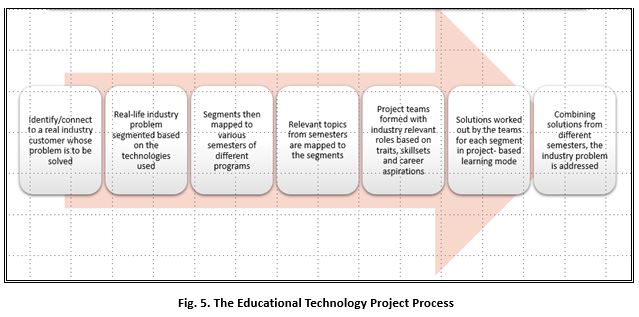
This process is based on the Additive Curriculum framework which creates a learning ecosystem with the following features (Fig. 6).
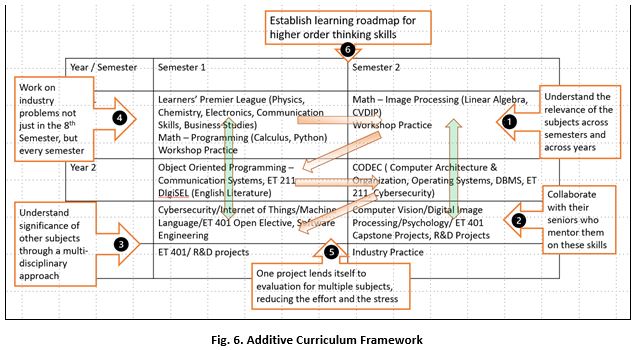
This framework addresses each of the lacunae mentioned above while meeting the objective that has been laid out earlier.
With this, students get equipped with Technology skills and the 21st-century workplace skills, can navigate unknown job readiness and situations, and can adapt to changing technologies easily. They also understand how value gets created for the customer.
Learning competencies that students develop –
- 1st Year – acquire new knowledge and information processing competencies for future processes, along with collaborative skills.
- 2nd Year – implement dynamic and efficient problem-solving skills to work on a real-life project in teams and demonstrate application development at a supervisory level.
- 3rd Year – create dynamic and effective problem-solving skills with specialization in Technology, Business, and Research & Discovery at a professional level, including work-flow management.
There is increased students’ engagement as evinced in the 72 projects of AY 2021-22 across the 1st and 2nd year BTech students as shown in Fig. 7.
By working on real Industry projects, students learnt industry-level tools for project management and image pre-processing, as well as open-source tools, making them industry-ready.
- Individualized Competency Certificate: students were able to develop their desired knowledge and skills competency in a subject domain. They are also awarded certificates for their competency in a “learning level” which they have demonstrated.
- The industry has endorsed it by sharing its satisfaction with the outcome of this approach because it has added value to them as a customer.
- External school groups have come forward to implement the program in their schools. An MoU has been signed with NU and this pedagogical initiative of Additive Curriculum has begun with the training of their teachers on the Mentoring skills required to implement such projects in schools.
- One of our MTech ET students, a teacher in the University of Kerala, has got the approval from the State Government for establishing a Centre of Excellence in Learning Engineering where she plans to introduce this pedagogy.
- Getting Industry partners willing to provide us projects that can follow the Additive Curriculum approach is challenging. Therefore, we connected to Startups which are more amenable to this kind of implementation.
- Managing 50+ projects each semester involving hundreds of students is a massive logistical task for which a dedicated team is required. The outcomes of each project role, each subject and each project must be defined appropriately for every one of these initiatives. It requires much coordination to form teams, allot mentors, define schedules, and implement them diligently in line with the academic calendar.
- We invited students to take ownership of such projects. This pedagogical initiative is executed by a student body called the Center of Excellence in Educational Technology (CoEET). This team plans, coordinates and executes these projects in consultation with the teachers.
- The Additive Curriculum is based on Brain Science supported by intensive research. Fundamental postulates of the working of the brain have been kept in mind when designing this.
- Learning has to be seen not as an individual effort, but a team effort. The current schooling prepares a student for the industrial age and is outdated. In today’s information and knowledge era, learning is necessarily a team game.
- Value has to be created for all stakeholders – Students, Teachers and Industry and this has to be kept in mind when designing the implementation.
- Successful implementation does not happen overnight but will evolve gradually. Processes have to be put into place systematically paving the way for incremental growth each year.
Evidence of Success
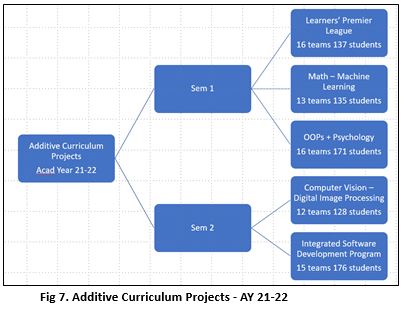
Problems Encountered and Resources Required
Notes
